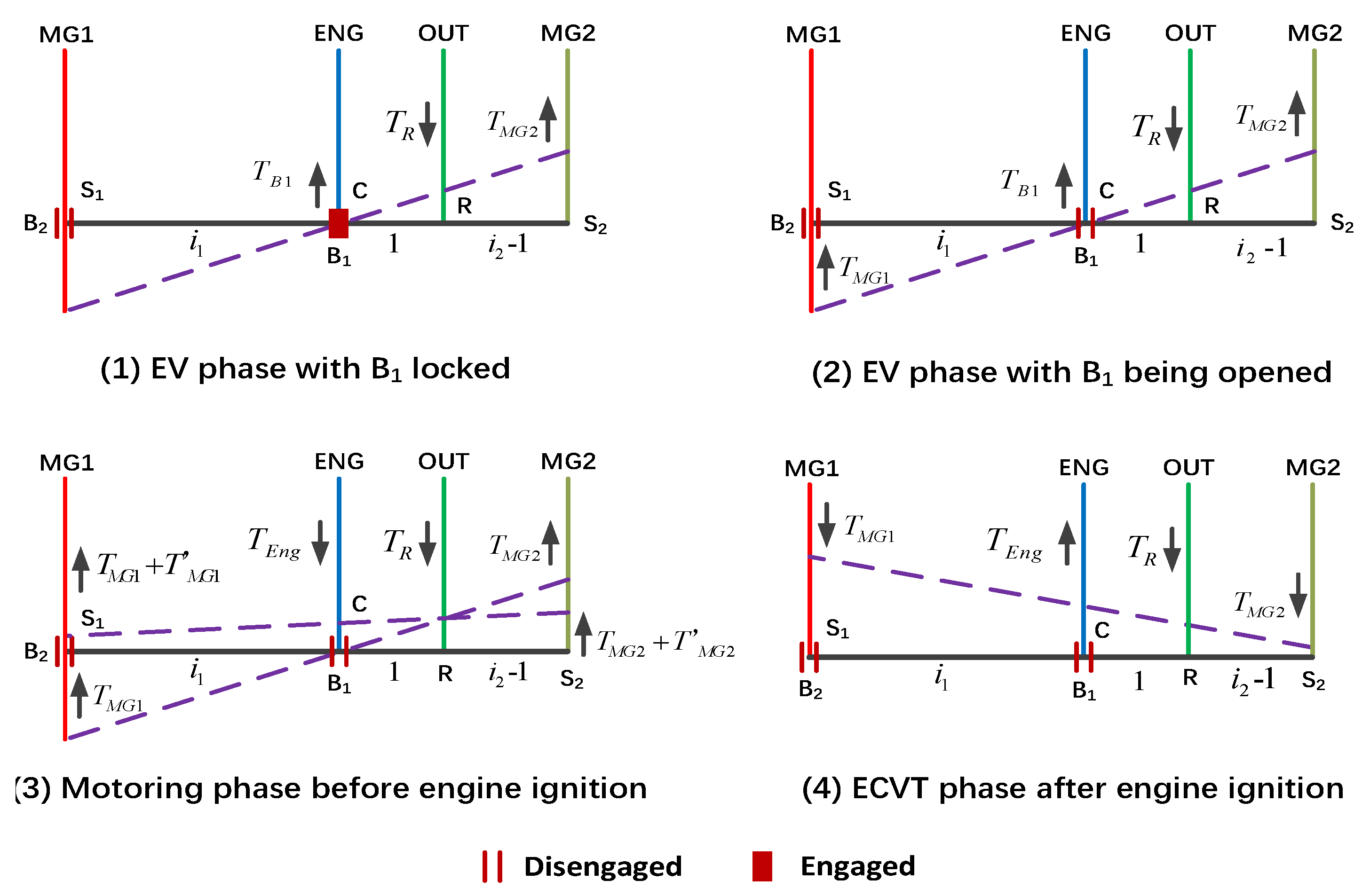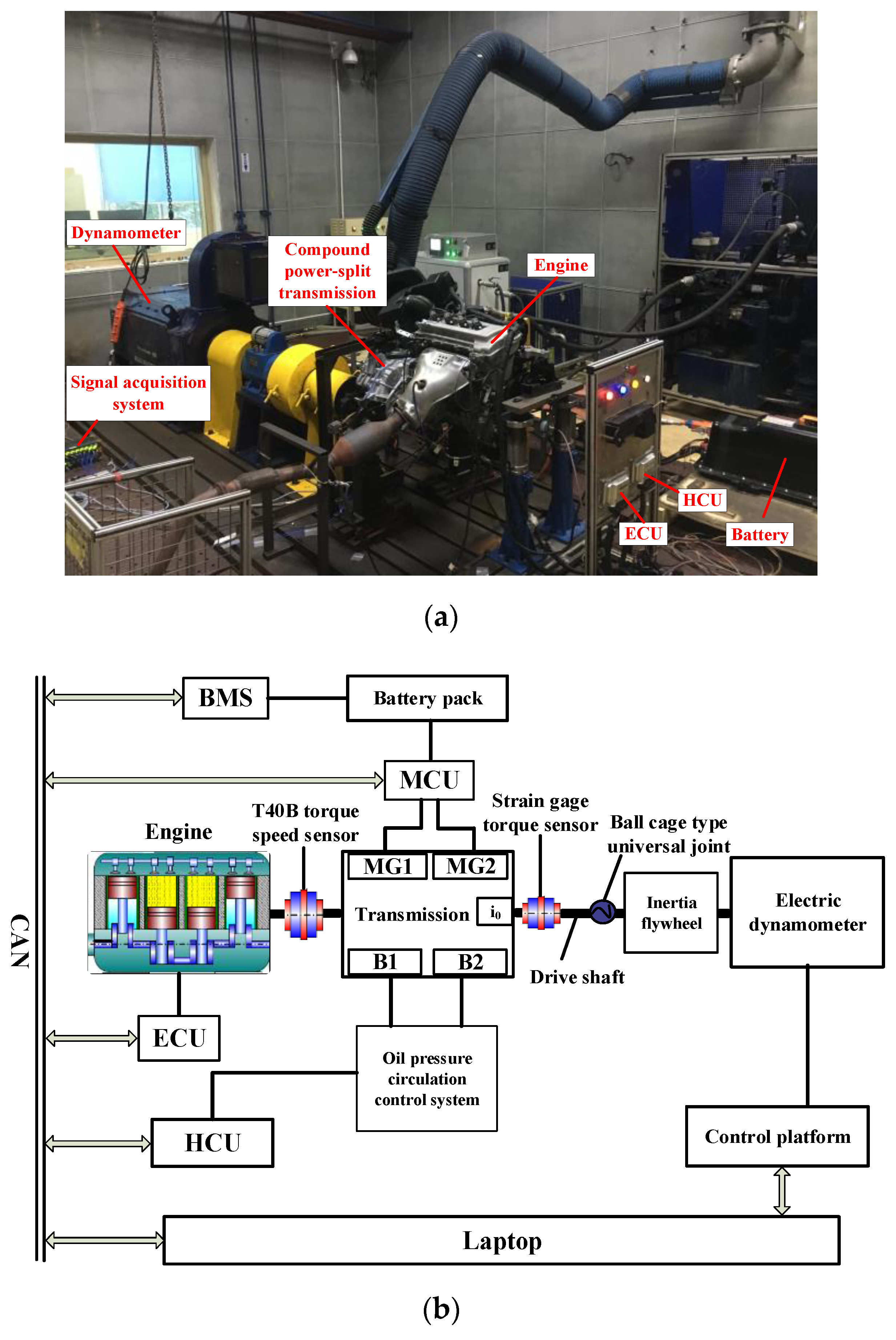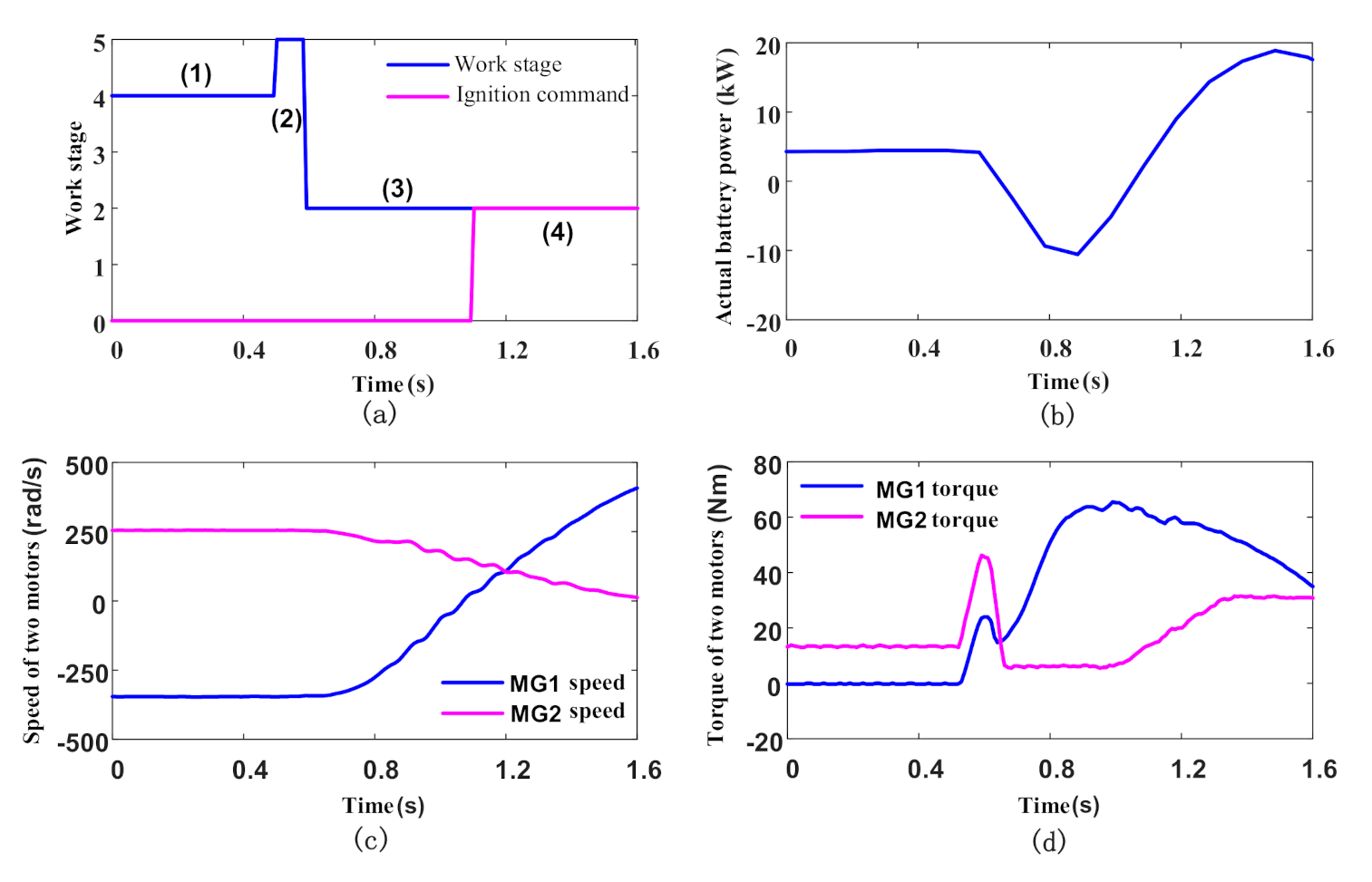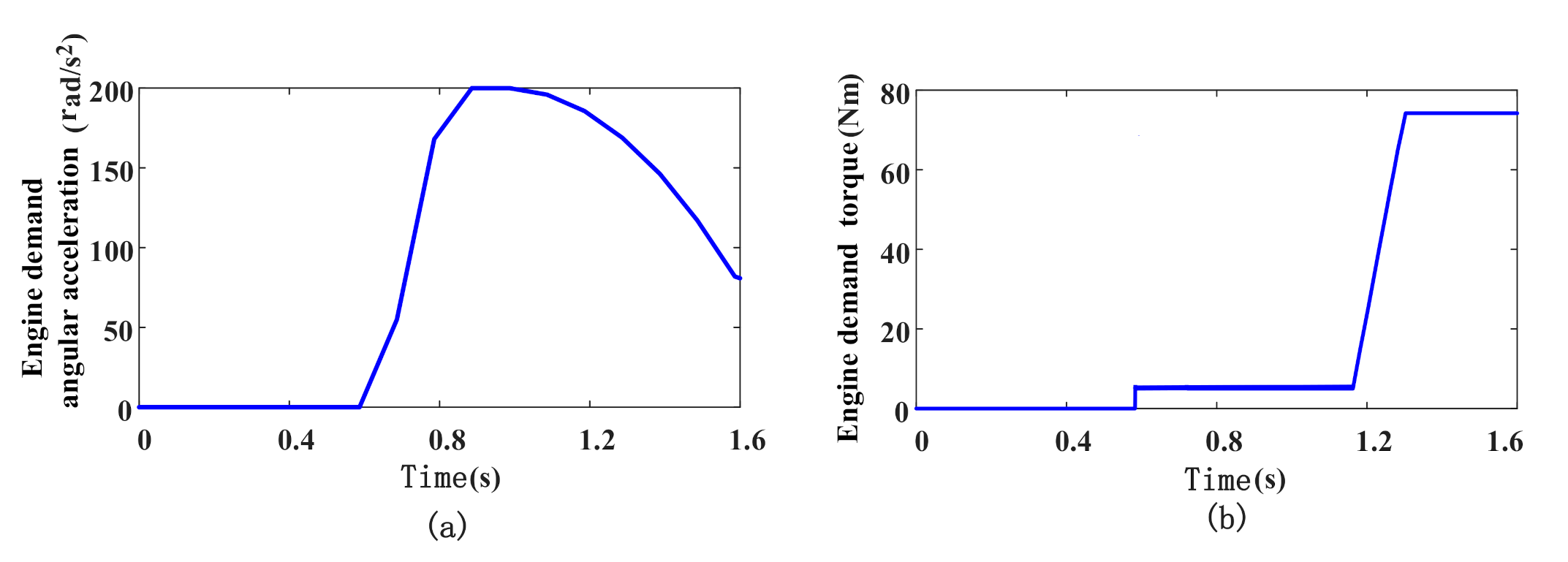Experimental and Characteristic Analysis during the Engine Start-Up Process for a Compound Power-Split Hybrid Electric Vehicle
Abstract
:1. Introduction
2. Structure of Compound Power-Split Hybrid Powertrain System
3. Control Strategy during Engine Start-Up Process
4. Test Bench System for Compound Power-Split Hybrid Electric Vehicle
5. Characteristic Analysis of Bench Test Results during Engine Starting Process
6. Conclusions
- (1)
- The small motor MG1 is the main power source of the starting engine, while the large motor MG2 is used to keep the powertrain system running stably. The battery is charged before ignition and discharged after ignition.
- (2)
- The actual engine speed and torque collected by the sensor are clearly different from those of the CAN network. In addition, the steady-state engine speed and torque could not reflect the actual output dynamic characteristics of the actual engine.
- (3)
- The excessive intake manifold pressure before engine ignition is one of the main reasons for the large output torque ripple. The sudden ignition advance angle and the amount of fuel injection after ignition caused great fluctuations in engine torque.
- (4)
- During the engine start-up process, especially in the electric starting phase before the engine’s ignition and the initial combustion process after ignition, the engine’s pulsating torque is the main reason for system jerk and vibration.
Author Contributions
Funding
Conflicts of Interest
References
- Ouyang, M.G.; Du, J.Y.; Peng, H.; Wang, H.W.; Feng, X.; Song, Z. Progress review of US-China joint research on advanced technologies for plug-in electric vehicles. Sci. China Technol. Sci. 2018, 61, 1431–1445. [Google Scholar] [CrossRef]
- Zhang, F.; Hu, X.; Langari, R.; Cao, D. Energy management strategies of connected HEVs and PHEVs: Recent progress and out-look. Prog. Energy Combust. Sci. 2019, 73, 235–256. [Google Scholar] [CrossRef]
- Wang, W.; Song, R.; Guo, M.; Liu, S. Analysis on compound-split configuration of power-split hybrid electric vehicle. Mech. Mach. Theory 2014, 78, 272–288. [Google Scholar] [CrossRef]
- Weili, W.U.; Xiong, Z.; Dongdong, L.I.; Jiangling, Z. Configuration Analysis of Mechatronic Coupling System in Hybrid Electric Ve-hicle. Automob. Parts 2016, 05, 1–4. [Google Scholar]
- Zeng, X.; Cui, H.; Song, D.; Yang, N.; Liu, T.; Chen, H.; Wang, Y.; Lei, Y. Jerk Analysis of a Power-Split Hybrid Electric Vehicle Based on a Data-Driven Vehicle Dynamics Model. Energies 2018, 11, 1537. [Google Scholar] [CrossRef] [Green Version]
- Canova, M.; Guezennec, Y.; Yurkovich, S. On the Control of Engine Start/Stop Dynamics in a Hybrid Electric Vehicle. J. Dyn. Syst. Meas. Control 2009, 131, 61005. [Google Scholar] [CrossRef]
- Yi, T.; Jianqiu, L.; Junzhi, Z.; Kexun, Z.; Minggao, Y. Coordinating Control Oriented Research on Algorithm of Engine Torque Estimation for Parallel Hybrid Electric Powertrain System. SAE Tech. Pap. 2004, 1, 4–24. [Google Scholar]
- Yunbing, Y.; Changqing, D. Experimental study on dynamic coordinated control of parallel hybrid electric Vehicle. Road Traffic Technol. 2010, 27, 34–47. [Google Scholar]
- Xian-Jun, H.; Chang-Qing, D.U.; Fu-Wu, Y.; Pei, H. Study on Mode Switching Technique of Hybrid Powertrain System. Chin. Intern. Combust. Engine Eng. 2009, 6, 72–76. [Google Scholar]
- Zhang, J. Experimental Research on Jerk of Hybrid Electric Vehicles. J. Mech. Eng. 2008, 44, 87–91. [Google Scholar] [CrossRef]
- Yang, Z.; Zhiguo, Z. Driving Performance Test and Analysis of ISG Single axis parallel hybrid Electric car. Mach. Electron. 2009, 9, 5–8. [Google Scholar]
- Hong, J.; Kim, S.; Min, B. Drivability Development Based on CoSimulation of AMESim Vehicle Model and Simulink HCU Model for Parallel Hybrid Electric Vehicle. Transm. Driveline 2009, 7, 1–6. [Google Scholar]
- Hu, M.; Jiang, G.; Fu, C.; Qin, D. Torque coordinated control in engine starting process for a single-motor hybrid electric vehicle. Adv. Mech. Eng. 2017, 9, 1–10. [Google Scholar] [CrossRef] [Green Version]
- Lin, Y.; Qin, D.; Liu, Y. Control strategy for all the mode-switches of hybrid electric vehicle. Adv. Mech. Eng. 2016, 8, 1687814016681233. [Google Scholar] [CrossRef] [Green Version]
- Yoshioka, T. Development of Noise and Vibration Reduction Technology on Hybrid Vehicle. J. Soc. Automot. Eng. Jpn. 2003, 57, 1–7. [Google Scholar]
- Yoshioka, T.; Sugita, H. Noise and vibration reduction technology in hybrid vehicle development. Trans. J. Passeng. Cars Mech. Syst. 2001, 1, 1–11. [Google Scholar]
- Komada, M.; Yoshioka, T. Noise and vibration reduction technology in new generation hybrid vehicle development. SAE Trans. 2005, 1, 2648–2655. [Google Scholar]
- Kawabata, N.; Komada, M.; Yoshioka, T. Noise and vibration reduction technology in the development of hybrid luxury sedan with series/parallel hybrid system. Trans. J. Passeng. Cars Mech. Syst. 2007, 1, 1–9. [Google Scholar]
- Wang, C.; Zhao, Z.; Zhang, T.; Li, M. Mode transition coordinated control for a compound power-split hybrid car. Mech. Syst. Signal Process. 2017, 87, 192–205. [Google Scholar] [CrossRef]
- Kuang, M.L. An investigation of engine start-stop NVH in a power split powertrain hybrid electric vehicle. Adv. Hybrid Veh. Powertrains 2006, 1, 1–14. [Google Scholar]
- Hwang, H.Y. Minimizing seat track vibration that is caused by the automatic start/stop of an engine in a power-split hybrid electric vehicle. J. Vib. Acoust. 2013, 135, 61007. [Google Scholar] [CrossRef]
- Chen, J.S.; Hwang, H.Y. Engine automatic start–stop dynamic analysis and vibration reduction for a two-mode hybrid vehicle. J. Automob. Eng. 2013, 227, 1303–1312. [Google Scholar] [CrossRef]
- Liu, D.; Zhang, J.; Zhang, D.; Liu, G.; Yu, H. Experimental and numerical analysis of the seat track vibrations caused by engine starts in a power-split hybrid electric vehicle. J. Automob. Eng. 2017, 231, 395–404. [Google Scholar] [CrossRef]
- Zhang, J.; Liu, D.; Yu, H. Experimental and numerical analysis for the transmission gear rattle in a power-split hybrid electric vehicle. Int. J. Veh. Des. 2017, 74, 1–18. [Google Scholar] [CrossRef]
- Kim, N.; Duoba, M.; Kim, N.; Rousseau, A. Validating Volt PHEV Model with Dynamometer Test Data Using Autonomie. SAE Int. J. Passeng. Cars Mech. Syst. 2013, 6, 985–992. [Google Scholar] [CrossRef]
- Davis, R.I.; Lorenz, R.D. Engine torque ripple cancellation with an integrated starter alternator in a hybrid electric vehicle: Implementation and control. IEEE Trans. Ind. Appl. 2003, 39, 1765–1774. [Google Scholar] [CrossRef]
- Tomura, S.; Ito, Y.; Kamichi, K.; Yamanaka, A. Development of Vibration Reduction Motor Control for Series-Parallel Hybrid System. Adv. Hybrid Veh. Powertrains 2006. [Google Scholar] [CrossRef]
- Kim, H.; Kim, J.; Lee, H. Mode Transition Control Using Disturbance Compensation for a Parallel Hybrid Electric Vehicle. Proc. Inst. Mech. Eng. J. Automob. Eng. 2011, 225, 150–166. [Google Scholar] [CrossRef]
- Kum, D.; Peng, H.; Bucknor, N.K. Control of Engine-Starts for Optimal Drivability of Parallel Hybrid Electric Vehicles. J. Dyn. Syst. Meas. Control 2013, 135, 21020. [Google Scholar] [CrossRef]









| Parameters | Values |
|---|---|
| Engine maximum torque/speed (Nm/rpm) | 145/3600 |
| MG1/MG2 maximum torque (Nm) | 96/246 |
| Planetary parameter of front row | –3.179 |
| Planetary parameter of rear row | 2.342 |
| Final drive ratio | 4.044 |
| Carrier inertia (kg⋅m2) | 0.0039 |
| Ring inertia (kg⋅m2) | 0.0017 |
| Inertia () of MG1 and (kg⋅m2) | 0.041 |
| Inertia () of MG2 and (kg⋅m2) | 0.0723 |
| Engine inertia (kg⋅m2) | 0.18 |
| Vehicle equivalent mass (kg) | 1538 |
| Wheel radius (m) | 0.31 |
| Vehicle frontal area (m2) | 2.19 |
| Air resistance coefficient | 0.307 |
| Tire rolling resistance coefficient | 0.0137 |
| Rated capacity of battery (Ah) | 37 |
| Rated voltage of battery (V) | 308 |
| Serial Number | Test Equipment | Parameters | Note |
|---|---|---|---|
| 1 | T40B torque speed sensor | Maximum torque 1000 Nm Maximum speed 20,000 rpm Accuracy class 0.05 | Measures engine torque and speed |
| 2 | Strain gauge torque sensor | Measured maximum 2000 Nm Accuracy 3% | Measures driveshaft torque |
| 3 | Vibration acceleration sensor | Measure frequency 10,000 Hz Measuring range −25 to 25 g Linear error 0.2% | Measures the vibration of the bench box |
| 4 | LMS SCADAS multi-function data acquisition system | Sampling rate up to 204.8 kHz Input range ±100 mV to ±10 V | Collects the signal data of each sensor of the platform system |
| Parameters | Value | Parameters | Value |
|---|---|---|---|
| Indoor temperature (°C) | 30 | Battery SOC | 0.15 |
| Engine coolant temperature (°C) | 42 | Maximum allowable battery discharge power (kW) | 72 |
| Engine inlet air temperature (°C) | 33 | Maximum allowable battery charge power (kW) | −84 |
| Engine intake VVT Angle (°) | 21 | Torque required at tooth ring (Nm) | 30 |
| Engine exhaust VVT Angle (°) | −19 | Engine target idle speed (rpm) | 1200 |
Publisher’s Note: MDPI stays neutral with regard to jurisdictional claims in published maps and institutional affiliations. |
© 2021 by the authors. Licensee MDPI, Basel, Switzerland. This article is an open access article distributed under the terms and conditions of the Creative Commons Attribution (CC BY) license (http://creativecommons.org/licenses/by/4.0/).
Share and Cite
Su, Y.; Hu, M.; Huang, J.; Su, L.; Qin, D. Experimental and Characteristic Analysis during the Engine Start-Up Process for a Compound Power-Split Hybrid Electric Vehicle. Appl. Sci. 2021, 11, 1846. https://doi.org/10.3390/app11041846
Su Y, Hu M, Huang J, Su L, Qin D. Experimental and Characteristic Analysis during the Engine Start-Up Process for a Compound Power-Split Hybrid Electric Vehicle. Applied Sciences. 2021; 11(4):1846. https://doi.org/10.3390/app11041846
Chicago/Turabian StyleSu, Yanzhao, Minghui Hu, Jin Huang, Ling Su, and Datong Qin. 2021. "Experimental and Characteristic Analysis during the Engine Start-Up Process for a Compound Power-Split Hybrid Electric Vehicle" Applied Sciences 11, no. 4: 1846. https://doi.org/10.3390/app11041846
APA StyleSu, Y., Hu, M., Huang, J., Su, L., & Qin, D. (2021). Experimental and Characteristic Analysis during the Engine Start-Up Process for a Compound Power-Split Hybrid Electric Vehicle. Applied Sciences, 11(4), 1846. https://doi.org/10.3390/app11041846





